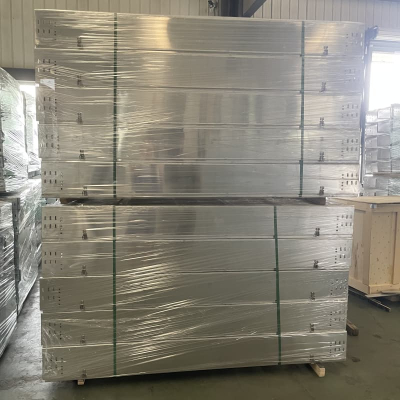What is the installation method of metal cable tray?
The installation method of metal cable tray should follow the specifications and process requirements to ensure its stability and resistance to use. The specifications and models that meet the design specifications should be selected, and the inside and outside should be smooth and flat, without edges, distortion or other defects.
Galvanized products should use matching galvanized accessories, and the galvanized layer should be smooth and uniform, without defects such as peeling, bubbles, partial uncoated, and rust. The paint layer of non galvanized products should be strong and rust free, and grounding screws should be welded on each section. It is recommended to use cold-rolled steel plates and choose the appropriate thickness of small plates according to the width of the cable tray or bridge. The structure of supports and hangers should meet the requirements of stiffness, strength, and stability. The mechanical properties of the weld seam shall not be lower than those of the main material, and the surface of the weld seam shall be uniform, without defects such as missed welding, cracks, slag inclusion, burn through, etc. Determine the direction of the laying location, perform line marking and positioning, and determine the fixed position of the support and hanger. The installation of cable trays should be ensured to be horizontal and vertical, and on buildings with slopes, the same slope as the building surface should be maintained.
When laid horizontally, the height above the ground should not be less than 2.5m, and when laid vertically, it should not be less than 1.8m. When the height is lower than the above, a metal cover plate should be added to protect the cable tray and bridge. When laying multiple layers, the distance between layers should meet the requirements. The fixing methods of supports and hangers can include pre embedded iron, direct welding on steel structures, expansion bolt fixation, etc. When embedding iron, the self-made processing dimensions and anchoring round steel diameter should meet the requirements and cooperate with the construction of civil engineering structures. When welding on steel structures, it should be ensured that the welding is firm. When using expansion bolts for fixation, the corresponding bolts and drill bits should be selected according to the load-bearing capacity, and the drilling depth should be ensured to be appropriate. The spacing between supports and hangers is generally 1.5 to 3 meters when laid horizontally.
When laying vertically, the spacing between fixed points should not exceed 2m. Fixed support points shall be set within 500mm of the three ends of the junction box, box, cabinet, corner, turning and deformation joint, and T-shaped joint for entry and exit. The installation of cable trays requires selecting a very good span and providing support according to the load curve. The support and hanger should be flush with the bottom surface of the bridge, without gaps or hanging phenomenon. The configuration of supports and hangers in non-linear sections should meet the requirements. The interface of the bridge should be flat and the joints should be tight and straight. The connection of the cable tray should be made using connection plates, washers, spring washers, nuts, etc., and ensure that the nuts are tightened on the outside of the cable tray. When crossing, turning, or connecting with a T-shaped connection, it is advisable to use the manufacturer's matching single, two-way, three-way, four-way, and other flexible connections.
Metal trunking trays should be reliably grounded or zeroed, but should not be used as grounding conductors for equipment. The two ends of the connecting plate between galvanized cable trays shall not be connected to the grounding wire, but there shall be no less than 2 connection fixing bolts with anti loosening nuts or anti loosening washers at both ends of the connecting plate. The two ends of the connecting plate between non galvanized cable trays should be bridged with copper core grounding wires, and ensure that the small allowable cross-sectional area of the grounding wire meets the requirements. When the bridge passes through walls, floors, and other parts, holes should be left in advance and sealed with non combustible materials. Fire sealing must be done inside the bridge frame passing through the fire compartment. When installing cable trays outdoors, the installation height should not be lower than the height of snow and accumulated water, and consideration should be given to using cover plates.




